Understanding Turtles and Their Shells
Turtles are reptiles, with around 250 species living in oceans, lakes, streams, forests, and deserts across all continents except Antarctica. They may even be found in your own backyard.
The Shape of a Turtle Shell
The first thing you’ll notice about a turtle is its shell. Shell shape—domed or flat—depends on species and habitat. Land-dwelling turtles usually have high-domed shells to protect against predators, while aquatic turtles have flat, streamlined shells for gliding through water.
Structure of the Shell
A turtle’s shell consists of two main parts: the carapace (top) and plastron (bottom). These halves are connected by a bony bridge at the sides. In species that can retract into their shells, a hinge allows the carapace and plastron to close tightly, joining the two halves together.
Both the carapace and plastron are made of bone. The upper shell contains 50–60 rib and back bones, while the lower shell fuses clavicle and rib bones. Each half is covered with scutes, overlapping keratin pieces (like human fingernails) that provide protection. Leatherback turtles and other soft-shelled species lack scutes, having tough cartilage skin instead.
Growth and Maintenance of the Shell
Unlike hermit crabs, turtles cannot replace their shells. The shell grows with the turtle because it is made from the rib cage and spine, attached to the internal bones. As turtles grow, scutes shed periodically to make way for larger ones. Basking in the sun helps dry and loosen old scutes, facilitating their shedding.
Some species, like the South American river turtle, assist one another in removing loose scutes or algae using their jaws. This process is gentle, as turtles can feel both pressure and pain through their shells.
Health Issues Related to Scute Shedding
Improper shedding can cause health problems. Dysecdysis is the abnormal shedding of scutes, which can lead to infections or leave the bones unprotected. Excessive or insufficient shedding has been linked to serious issues, including renal failure in turtles.

